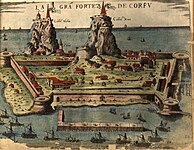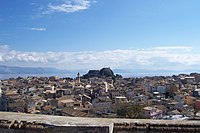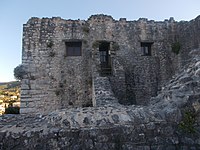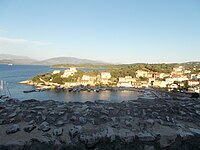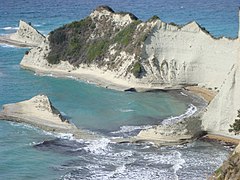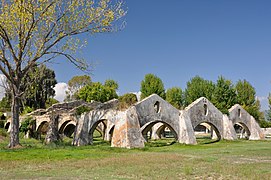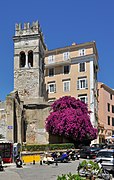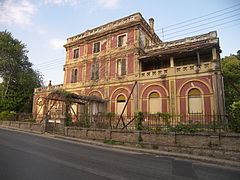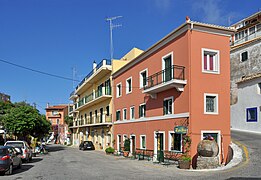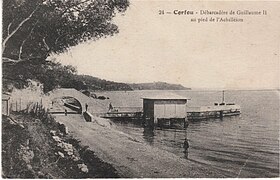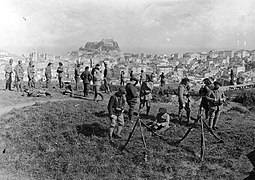Corfu
Native name: Κέρκυρα Nickname: Το νησί των Φαιάκων (The island of Faiakes) | |
|---|---|
UTC+3) | |
| Postal code | 490 81, 490 82, 490 83, 490 84, 491 31, 491 32 (former 491 00) |
| Area code(s) | 26610, 26620, 26630 |
| Official website | www |
Corfu (
The island is bound up with the
In 2007, the city's old town was added to the
Name
The Greek name, Kerkyra or
The name Corfù is a Venetian and Italian version of the
Geography
The northeastern edge of Corfu lies off the coast of Sarandë, Albania, separated by straits varying in width from 3 to 23 km (2 to 14 miles). The southeast side of the island lies off the coast of Thesprotia, Greece. Its shape resembles a sickle (drepanē, δρεπάνι), to which it was compared by the ancients: the concave side, with the city and harbour of Corfu in the centre,[15] lies toward the Albanian coast. With the island's area estimated at 592.9 km2 (228.9 sq mi; 146,500 acres),[16] it runs approximately 64 km (40 mi) long, with greatest breadth at around 32 km (20 mi).
Two high and well-defined ranges divide the island into three districts, of which the northern is mountainous, the central undulating, and the southern low-lying. The more important of the two ranges, that of Pantokrator (Παντοκράτωρ – the Almighty) stretches east and west from Cape Falacro to Cape Psaromita, and attains its greatest elevation in the summit of the same name.[15]
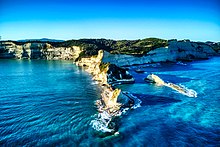
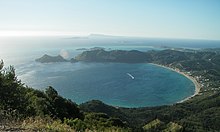
The second range culminates in the mountain of Santi Jeca, or Santa Decca, as it is called by misinterpretation of the Greek designation Άγιοι Δέκα (Hagioi Deka), or the Ten Saints. The whole island, composed as it is of various limestone formations, presents great diversity of surface.
Corfu's coastline spans 217 km (135 mi) including capes; its highest point is Mount Pantokrator (906 m (2,972 ft)); and the second Stravoskiadi, at 849 m (2,785 ft). The full extent of capes and promontories take in Agia Aikaterini, Drastis to the north, Lefkimmi and Asprokavos to the southeast, and Megachoro to the south. Two islands are also to be found at a middle point of Gouvia and Corfu Bay, which extends across much of the eastern shore of the island; are known as Lazareto and Ptychia (or Vido).
Diapontia Islands

The
Lazaretto Island
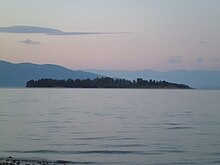
Climate
Corfu has a
| Climate data for Corfu (1955-2010) HNMS 1 m asl
| |||||||||||||
|---|---|---|---|---|---|---|---|---|---|---|---|---|---|
| Month | Jan | Feb | Mar | Apr | May | Jun | Jul | Aug | Sep | Oct | Nov | Dec | Year |
| Record high °C (°F) | 21.0 (69.8) |
23.0 (73.4) |
26.0 (78.8) |
28.0 (82.4) |
34.0 (93.2) |
41.0 (105.8) |
42.8 (109.0) |
40.0 (104.0) |
37.4 (99.3) |
33.0 (91.4) |
27.8 (82.0) |
22.0 (71.6) |
42.8 (109.0) |
| Mean daily maximum °C (°F) | 13.9 (57.0) |
14.1 (57.4) |
16.0 (60.8) |
19.1 (66.4) |
24.0 (75.2) |
28.2 (82.8) |
31.2 (88.2) |
31.5 (88.7) |
27.5 (81.5) |
23.2 (73.8) |
18.7 (65.7) |
15.2 (59.4) |
21.9 (71.4) |
| Daily mean °C (°F) | 9.8 (49.6) |
10.2 (50.4) |
12.1 (53.8) |
15.2 (59.4) |
19.9 (67.8) |
24.2 (75.6) |
26.7 (80.1) |
26.6 (79.9) |
22.7 (72.9) |
18.5 (65.3) |
14.4 (57.9) |
11.2 (52.2) |
17.6 (63.7) |
| Mean daily minimum °C (°F) | 5.3 (41.5) |
5.7 (42.3) |
7.1 (44.8) |
9.6 (49.3) |
13.3 (55.9) |
16.9 (62.4) |
18.9 (66.0) |
19.3 (66.7) |
16.8 (62.2) |
13.7 (56.7) |
10.2 (50.4) |
7.0 (44.6) |
12.0 (53.6) |
| Record low °C (°F) | −6.0 (21.2) |
−4.2 (24.4) |
−4.4 (24.1) |
−0.2 (31.6) |
4.6 (40.3) |
8.7 (47.7) |
10.0 (50.0) |
11.3 (52.3) |
7.2 (45.0) |
2.8 (37.0) |
−2.2 (28.0) |
−2.0 (28.4) |
−6.0 (21.2) |
| Average rainfall mm (inches) | 135.8 (5.35) |
123.1 (4.85) |
99.6 (3.92) |
65.2 (2.57) |
36.5 (1.44) |
15.5 (0.61) |
8.7 (0.34) |
21.7 (0.85) |
87.8 (3.46) |
140.4 (5.53) |
187.1 (7.37) |
189.9 (7.48) |
1,111.3 (43.75) |
| Average rainy days | 14.8 | 13.4 | 12.9 | 12.2 | 7.7 | 4.8 | 3.3 | 3.3 | 7.4 | 11.4 | 14.7 | 16.5 | 122.4 |
| Average relative humidity (%)
|
75.6 | 74.1 | 73.1 | 72.5 | 69.2 | 63.2 | 61.7 | 61.7 | 70.3 | 74.9 | 77.5 | 77.1 | 70.9 |
| Mean monthly sunshine hours | 117.7 | 116.8 | 116.0 | 206.5 | 276.8 | 324.2 | 364.5 | 332.8 | 257.1 | 188.9 | 133.5 | 110.9 | 2,545.7 |
| Source 1: InfoClimat extremes 1991-present [20]
Hellenic National Meteorological Service[21] | |||||||||||||
| Source 2: NOAA (extremes and sun 1961−1990)[22] | |||||||||||||
Biodiversity
Flora
Homer identifies six plants that adorn the garden of Alcinous: wild olive, pear, pomegranate, apple, fig and grape vine. Of these the apple and the pear are very inferior in Corfu; the others thrive, together with all the fruit trees known in Southern Europe, with addition of the kumquat, loquat and prickly pear and, in some spots, the banana. Olive trees dominate and their combination with cypress trees compose the typical Corfiot landscape. When undisturbed by cultivation,[15] the high maquis is the major natural vegetation type followed by deciduous oak forests and to a lesser extent, pine forests. In total more than 1800 plant species have been recorded.[24]
Fauna
Corfu is a
Birds
Avifauna is extensive, with around 300 bird species recorded since the 19th century. Species vary in size from the
Mammals
Around 40 species of mammals live on the island and in the sea around it.
Amphibians and reptiles
Eight species of amphibians and 31 species of reptiles live or have been recorded on and around Corfu.[37]
The
Lizard species include typical lizards and geckos like the starred agama, the Mediterranean house gecko, the moorish gecko, the Dalmatian algyroides, the common wall lizard, the Balkan wall lizard, the Balkan green lizard, the European green lizard and the snake-eyed skink as also the legless Greek slow worm and the European glass lizard.
Of the snakes of Corfu, only the
Butterflies
There are 75 (plus) known species of Corfiot butterfly. Of particular interest are the
Corfu Butterfly Conservation
Corfu Butterfly Conservation (CBC) was launched in April 2019. The group is composed of concerned residents, island visitors and scientists from throughout Europe.[39] Their goals are to produce robust scientific data that can be used to influence policy and protect habitat for the benefit of Corfu's butterflies and the wider natural environment, as well as to stimulate public interest in butterfly conservation.
CBC launched its website (www.corfubutterflyconservation.org, funded by the Royal Entomological Society's Goodman Award) on the 1 January 2021 to coincide with the launch of the Corfu Butterfly Survey.[40] The website describes the 75 species of butterflies that have been confirmed by members of CBC from the island. It outlines the value of butterflies as indicators of the island's biodiversity status and encourages enthusiasts to record their sightings on this website, as participants of the survey.[38] On the 16 December 2021, CBC became a UK registered community interest company (No.13813164) and so its identity changed from being a project to that of an organisation.[38]
History
Early history

The earliest reference to Corfu is the
Some scholars have asserted that Corfu is
According to Strabo (VI, 269), the Liburnians were masters of the island Korkyra (Corfu) for a time, until the 8th century BCE. They reportedly were expelled from Korkyra by the Corinthians.[45][46][47]
At a date no doubt previous to the foundation of
This opposition came to a head in the early part of the 7th century BC, when their fleets fought the first naval battle recorded in Greek history: 665 BC according to
This new alliance was one of the chief immediate causes of the Peloponnesian War, in which Corcyra was of considerable use to the Athenians as a naval station, but did not render much assistance with its fleet. The island was nearly lost to Athens by two attempts of the oligarchic faction to effect a revolution; on each occasion the popular party ultimately won the day and took a most bloody revenge on its opponents (427 BC and 425 BC).[48][15]
During the
In 303 BC, after a vain siege by
Roman and medieval history
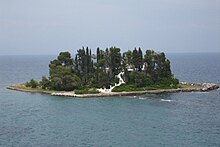
Christianity arrived in Corfu early; two disciples of
During
From at least the early 9th century, Corfu and the other Ionian Islands formed part of the theme of Cephallenia.[53] This naval theme provided a defensive bulwark for Byzantium against western threats, but also played a major role in securing the sealanes to the Byzantine possessions in southern Italy. Indeed, traveller reports from throughout the middle Byzantine period (8th–12th centuries) make clear that Corfu was "an important staging post for travels between East and West".[54] Indeed, the medieval name of Corfu first appears (Latinized Coryphus) in Liutprand of Cremona's account of his 968 embassy to the Byzantine court.[55] Corfu enjoyed relative peace and safety during the Macedonian dynasty (867–1054), which allowed the construction of a monumental church to Saints Iason and Sosipatrus outside the city wall of Palaiopolis.[55] Nevertheless, in 933, the city, led by its archbishop, Arsenios, withstood a Saracen attack; Arsenios was canonized and became the city's patron saint.[56]
The peace and prosperity of the Macedonian era ended with another Saracen attack in 1033, but more importantly with the emergence of a new threat: following the
During the break-up of the
The island was one of the first places in Europe in which
Venetian rule

From medieval times and into the 17th century, the island was recognised as a bulwark of the European States against the
Kerkyra, the "Door of Venice" during the centuries when the whole Adriatic was the Gulf of Venice,[69] remained in Venetian hands from 1401 until 1797, though several times assailed by Ottoman naval and land forces[15] and subjected to four notable sieges in 1537, 1571, 1573 and 1716, in which the strength of the city defences asserted itself time after time. The effectiveness of the powerful Venetian fortifications as well as the strength of some old Byzantine castles in Angelokastro, Kassiopi Castle, Gardiki and elsewhere, were additional factors that enabled Corfu to remain free. Will Durant claimed that Corfu owed to the Republic of Venice the fact that it was one of the few parts of Greece never conquered by the Ottomans.[70]
A series of attempts by the
The Siege of Corfu (1537) was the first great siege by the Ottomans. It began on 29 August 1537, with 25,000 soldiers from the Ottoman fleet landing and pillaging the island and taking 20,000 hostages as slaves. Despite the destruction wrought on the countryside, the city castle held out in spite of repeated attempts over twelve days to take it, and the Turks left the island unsuccessfully because of poor logistics and an epidemic that decimated their ranks.[71]
Thirty-four years later, in August 1571, Ottoman forces returned for yet another attempt to conquer the island. Having seized
These defeats in the east and the west of the island proved decisive, and the Ottomans abandoned their siege and departed. Two years later they repeated their attempt. Coming from Africa after a victorious campaign, they landed in Corfu and wreaked havoc on rural areas. Following a counterattack by the Venetian-Corfiot forces, the Ottoman troops were forced to leave the city sailing away.[71]

The
Venetian policies and legacy
Corfu's urban architecture differs from that of other major Greek cities, because of Corfu's unique history. From 1386 to 1797, Corfu was ruled by Venetian nobility; much of the city reflects this era when the island belonged to the Republic of Venice, with multi-storeyed buildings on narrow lanes. The Old Town of Corfu has clear Venetian influence and is amongst the World Heritage Sites in Greece. It was in the Venetian period that the city saw the erection of the first opera house (Nobile Teatro di San Giacomo di Corfù) in Greece.
Many Venetian-speaking families settled in Corfu during these centuries; they were called
Venetians promoted the
The island served also as a refuge for Greek scholars, and in 1732, it became the home of the first academy of modern Greece.[15] A Corfu cleric and scholar, Nikephoros Theotokis (1732–1800) became renowned in Greece as an educator, and in Russia (where he moved later in his life) as an Orthodox archbishop.
The island's culture absorbed Venetian influence in a variety of ways; like other Ionian islands (see
-
VenetianOld Fortress, Map 1573
-
Panoramic view of Corfu (city) from the New Fortress
-
Detail of the south wing of the entrance at Kassiopi Castle
-
View of Kasiopi village from the castle
19th century
By the 1797
Following the final defeat of
Following a plebiscite the
British Lord High Commissioners during the protectorate
This is a list of the British High Commissioners of the Ionian Islands; (as well as the transitional Greek Governor, appointed a year prior to Enosis (Union) with Greece in 1864).[74]
- Sir James Campbell 1814–1816
- Sir Thomas Maitland(1759–1824) 1815–1823
- Sir Frederick Adam (1781–1853) 1823–1832
- Sir Alexander Woodford(1782–1870) 1832
- George Nugent-Grenville, 2nd Baron Nugent (1788–1850) 1832–1835
- Howard Douglas (1776–1861) 1835–1840
- James Alexander Stewart-Mackenzie (1784–1843) 1840–1843
- John Colborne, 1st Baron Seaton (1778–1863) 1843–1849
- Sir Henry George Ward (1797–1860) 1849–1855
- Sir John Young (1807–1876) 1855–1859
- William Ewart Gladstone (1809–1898) 1859
- Sir Henry Knight Storks (1811–1874) 1859–1863
- Count Dimitrios Nikolaou Karousos, President of the Ionian Parliament (1799–1873) 1863–1864
First World War
During the
Interwar period
In 1923, after a diplomatic dispute between Italy and Greece, Italian forces bombarded and occupied Corfu. The League of Nations settled this Corfu incident in Italy's favour.
Second World War
Italian occupation and resistance

During the
German bombing and occupation

Upon the fall of Italian fascism in 1943, the Nazis moved to take control of the island. On 14 September 1943, Corfu was bombarded by the Luftwaffe. The Nazi bombing raids destroyed most of the city's buildings, including churches, homes, and whole city blocks, especially in the Jewish quarter Evraiki. Other losses included the city's market (αγορά) and the hotel Bella Venezia. The worst losses were the historic buildings of the Ionian Academy (Ιόνιος Ακαδημία), the Municipal Theatre (which in 1901 had replaced the Nobile Teatro di San Giacomo di Corfù), the Municipal Library, and the Ionian Parliament.[76]
Following the
Liberation

Corfu was liberated by
Post–World War and modern Corfu
After World War II and the
Architecture

Venetian influence
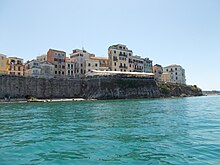
Corfu's urban architecture influence derives from Venice, reflecting the fact that from 1386 to 1797 the island was ruled by the Venetians. The architecture of the Old Town of Corfu along with its narrow streets, the kantounia, has clear Venetian influence and is amongst the World Heritage Sites in Greece. Other notable Venetian-era buildings include the Nobile Teatro di San Giacomo di Corfù, the first Greek opera house, and Liston, a multi-level commercial and residential building, with an arched colonnade at ground level, lined with cafes and restaurants on its east side, and restaurants and other stores on its west side. Liston's main thoroughfare is often the site of parades and other mass gatherings. Liston is on the edge of the Spianada (Esplanade), the vast main plaza and park which incorporates a cricket field, a pavilion, and Maitland's monument. Also notable are the Old and New forts, the recently restored Palace of Sts. Michael and George, formerly the residence of the British colonial governor and the seat of the Ionian Senate, and the summer Palace of Mon Repos, formerly the property of the Greek royal family and birthplace of the Prince Philip, Duke of Edinburgh. The Park of Mon Repos is built on part of the Palaiopolis of Kerkyra, where excavations were conducted by the Greek Archaeological Service in collaboration with academics and universities internationally. Examples of the finds can be found in the Museum of the Palace of Mon Repos and at the Archaeological Museum of Corfu.[92]
The Achilleion

In 1889,

The Imperial gardens on the hill look over the surrounding green hills and valleys and the
The hero is presented devoid of rank or status, and seems notably human, though heroic, as he is forever trying to pull Paris's arrow from his heel. His classically depicted face is full of pain. He gazes skyward, as if to seek help from Olympus. According to Greek mythology, his mother Thetis was a goddess.[citation needed]
In contrast, at the great staircase in the main hall is a giant painting of the triumphant Achilles full of
In 1898, Empress Sissi was assassinated at the age of 60 by an Italian anarchist,
To the Greatest Greek from the Greatest German
The inscription was subsequently removed after World War II.[94]
The Achilleion was eventually acquired by the Greek state and has now been converted into a museum.
Kaiser's Bridge

German
Urban landscape
Old town
The Old Town of
The city of Corfu stands on the broad part of a peninsula, whose termination in the Venetian citadel (Greek: Παλαιό Φρούριο) is cut off from it by an artificial fosse formed in a natural gully, with a seawater moat at the bottom,[15] that now serves as a marina and is called the Contrafossa. In the old town there are many narrow streets paved with cobblestones. These streets are known as kantoúnia (Greek: καντούνια), and the older amongst them sometimes follow the gentle irregularities of the ground; while many are too narrow for vehicular traffic. A promenade rises by the seashore towards the bay of Garitsa (Γαρίτσα), together with an esplanade between the city and the citadel known as Spianada with the Liston arcade (Greek: Λιστόν) to its west side, where restaurants and bistros abound.[1]
Ano and Kato Plateia and the music pavilion
Near the old Venetian Citadel a large square called Spianada is also to be found, divided by a street in two parts: "Ano Plateia" (literally: "Upper square") and "Kato Plateia" (literally: "Lower square"), (Ανω Πλατεία and Κάτω Πλατεία in Greek). This is the biggest square in South-Eastern Europe and one of the largest in Europe,
Palaia Anaktora and its gardens
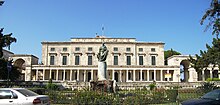

Just to the north of "Kato Plateia" lie the "Palaia Anaktora" (Παλαιά Ανάκτορα: literally "Old Palaces"): a large complex of buildings of Roman architectural style which formerly housed the Kings of Greece, and prior to that the
Churches
In the city, there are thirty-seven Greek churches, the most important of which are the city's cathedral, the church dedicated to Our Lady of the Cave (η Παναγία Σπηλιώτισσα (hē Panagia Spēliōtissa)); Saint Spyridon Church, wherein lies the preserved body of the patron saint of the island; and finally the suburban church of St Jason and St Sosipater (Αγιοι Ιάσων και Σωσίπατρος), reputedly the oldest in the island,[15] and named after the two saints probably the first to preach Christianity to the Corfiots.
Pontikonisi
The nearby island, known as Pontikonisi (Greek meaning "mouse island"), though small is very green with abundant trees, and at its highest natural elevation (excluding its trees or man-made structures, such as the monastery), stands at about 2 m (6 ft 6.74 in). Pontikonisi is home of the monastery of Pantokrator (Μοναστήρι του Παντοκράτορος); the white stone staircase of the monastery, viewed from afar, gives the impression of a (mouse) tail, which lent the island its name.
Archaeology
Palaiopolis
In the city of Corfu, the ruins of the ancient city of Korkyra, also known as Palaiopolis, include ancient temples which were excavated at the location of the palace of Mon Repos, which was built on the ruins of the Palaiopolis. The temples are: Kardaki Temple, Temple of Artemis, and the Temple of Hera. Hera's temple is situated at the western limits of Mon Repos, close to Kardaki Temple and to the northwest.[101] It is approximately 700 m. to the southeast of the Temple of Artemis in Corfu.[101] Hera's Temple was built at the top of Analipsis Hill, and, because of its prominent location, it was highly visible to ships passing close to the waterfront of ancient Korkyra.[101]
Kardaki Temple

Kardaki Temple is an
It is considered to be the only Greek temple of Doric architecture that does not have a frieze.[102] The spacing of the temple columns has been described as "abnormally wide".[105] The temple also lacked both porch and adyton, and the lack of a triglyph and metope frieze may be indicative of Ionian influence.[106] The temple at Kardaki is considered an important and to a certain degree mysterious topic on the subject of early ancient Greek architecture. Its association with the worship of Apollo or Poseidon has not been established.
Temple of Artemis

The Temple of Artemis is an
The temple was a
The
Temple of Hera

The Temple of Hera or Heraion is an
Large
The Digital Archaic Heraion Project at Mon Repos is a project that has undertaken the task of
Tomb of Menecrates


The Tomb of Menecrates or Monument of Menecrates is an Archaic cenotaph in Corfu, built around 600 BC in the ancient city of Korkyra (or Corcyra).[114][115] The tomb and the funerary sculpture of a lion were discovered in 1843 during demolition works by the British Army who were demolishing a Venetian fortress in the location of Garitsa hill in Corfu.[116] The tomb is dated to the 6th century BC.[116]
The lion is dated at the end of the 7th century BC and it is one of the earliest funerary lions ever found.
Other archaeological sites
In Cassiope, the only other city of ancient importance, its name is still preserved by the village of Kassiopi, and there are some rude remains of building on the site; but the temple of Zeus Cassius for which it was celebrated has totally disappeared.
Castles
The castles of Corfu, located at strategic points on the island helped defend the island from many invaders and they were instrumental in repulsing repeated Turkish invasions, making Corfu one of the few places in Greece never to be conquered by the Ottomans.
Palaio Frourio
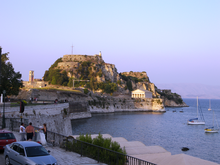

The old citadel (in Greek Palaio Frourio (Παλαιό Φρούριο) is an old Venetian fortress built on an artificial islet with fortifications surrounding its entire perimeter, although some sections, particularly on the east side, are slowly being eroded and falling into the sea. Nonetheless, the interior has been restored and is in use for cultural events, such as concerts (συναυλίες) and Sound and Light Productions (Ηχος και Φως), when historical events are recreated using sound and light special effects. These events take place amidst the ancient fortifications, with the Ionian sea in the background. The central high point of the citadel rises like a giant natural
architectural style of the greater part of Greek Orthodox churches.Neo Frourio

The new citadel or Neo Frourio (Νέο Φρούριο, "New Fortress") is a huge complex of fortifications built by the British during their
Angelokastro

Angelokastro (
Angelokastro is one of the most important fortified complexes of Corfu. It was an acropolis which surveyed the region all the way to the southern
Angelokastro formed a defensive triangle with the castles of Gardiki and Kassiopi, which covered Corfu's defences to the south, northwest and northeast. The castle never fell, despite frequent sieges and attempts at conquering it through the centuries, and played a decisive role in defending the island against pirate incursions and during three sieges of Corfu by the Ottomans, significantly contributing to their defeat. During invasions it helped shelter the local peasant population. The villagers also fought against the invaders playing an active role in the defence of the castle. Angelokastro, located at the western frontier of the Empire, was instrumental in repulsing the Ottomans during the first great siege of Corfu in 1537, in the siege of 1571 and the second great siege of Corfu in 1716 causing the Ottomans to fail at penetrating the defences of Corfu in the North. Consequently the Turks were never able to create a beachhead and to occupy the island.[125]
Gardiki Castle
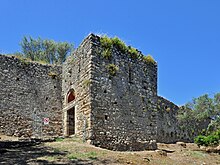
Gardiki Castle (
The location of Gardiki at the narrow southwest flank of Corfu provided protection to the fields and the southern lowlands of Corfu and in combination with Kassiopi Castle on the northeastern coast of the island and Byzantine Angelokastro protecting the northwestern shore of Corfu, formed a triangular line of defence which protected Corfu during the pre-Venetian era.[127][128][129]
Kassiopi Castle

Kassiopi Castle (Greek: Κάστρο Κασσιώπης) is a castle on the northeastern coast of Corfu overseeing the fishing village of Kassiopi.[130] It was one of three Byzantine-period castles that defended the island before the Venetian era (1386–1797). The castles formed a defensive triangle, with Gardiki guarding the island's south, Kassiopi the northeast and Angelokastro the northwest.[128][129]
Its position at the northeastern coast of Corfu overseeing the
Kassiopi Castle is considered one of the most imposing architectural remains in the Ionian Islands,[131] along with Angelokastro, Gardiki Castle and the two Venetian Fortresses of Corfu City, the Citadel and the New Fort.[131]
Since the castle was abandoned for a long time, its structure is in a state of ruin. The eastern side of the fort has disappeared and only a few traces of it remain. There are indications that castle stones have been used as building material for houses in the area. Access to the fortress is mainly from the southeast through a narrow walkway which includes passage from homes and backyards, since the castle is at the centre of the densely built area of the small village of Kassiopi.[132][133]
Municipalities
The three present municipalities of Corfu and Diapontia Islands were formed in the 2019 local government reform from the former municipality Corfu.[3][134]
- Central Corfu and Diapontia Islands
- North Corfu
- South Corfu
Education
Ionian Academy

The
Ionian University

The Ionian University was established in 1984, in recognition, by the administration of Andreas Papandreou, of Corfu's contribution to Education in Greece, as the seat of the first Greek university in modern times,[138] the Ionian Academy. The university opened its doors to students in 1985 and today comprises three Schools and six Departments offering undergraduate and post-graduate degree programmes and summer schools.[139][140]
Student activism
In the modern era, beginning with its massive student protests during World War II against fascist occupation, and continuing in the fight against the dictatorship of
Culture
Corfu has a long musical, theatrical, and operatic tradition. The operas performed in Corfu were at par with their European counterparts. The phrase "applaudito in Corfu" (applauded in Corfu) was a measure of high accolade for an opera performed on the island. The Nobile Teatro di San Giacomo di Corfù was the first theatre and opera house of modern Greece and the place where the first Greek opera, Spyridon Xyndas' The Parliamentary Candidate (based on an exclusively Greek libretto) was performed.
Museums and libraries
The most notable of Corfu's museums and libraries are located in the city; these include:[141]
- Kaiser Wilhelm II had developed a "lifelong obsession" with the Gorgon sculpture, dating from seminars on Greek Archaeology the Kaiser attended while at the University of Bonn. The seminars were given by archaeologist Reinhard Kekulé von Stradonitz, who later became the Kaiser's advisor.[93]In 1994, two more halls were added to the museum, where new discoveries from the excavations of the ancient city and the Garitsa cemetery are exhibited.
- The Museum of Asian art of Corfu is located at the Palace of St. Michael and St. George (mainly Chinese and Japanese Arts); its unique collection is housed in 15 rooms, taking in over 12,000 artifacts, including a Greco-Buddhist art collection that shows the influence of Alexander the Great on Buddhist culture as far as Pakistan (see Greco-Buddhism).
- The Banknote Museum, located in Aghios Spyridon square, features a complete collection of Greek banknotes from independence to the adoption of the euroin 2002.
- The Byzantine Museum of Antivouniotissa, a church converted into a museum featuring rare Byzantine art.
- Kapodistrias Museum. Ioannis Kapodistrias' summer home in Koukourisa in his birthplace of Corfu has been converted to a museum commemorating his life and accomplishments and has been named in his honour.[143] Donated by Maria Desylla Kapodistria, grand niece of Ioannis Kapodistrias, former mayor of Corfu and first female mayor of Greece.
- The Music Museum of the Philharmonic Society of Corfu is located in the building of the Philharmonic Society and features scores, instruments, paintings and documents related to the music history of Corfu and the 19th-century Ionian Islands.

- The Public Library of Corfu is located at the old English Barracks, in Palaio Frourio.
- The Reading Society of Corfu has an extensive library of old Corfu manuscripts and rare books.
- The Austro-Hungarianattack of 6 October 1915. Exhibits include photographs from the three years stay of the Serbians in Corfu, together with other exhibits such as uniforms, arms and ammunition of the Serbian army, Serbian regimental flags, religious artifacts, surgical tools and other decorations of the Kingdom of Serbia.
- Solomos Museum and the Corfiot Studies Society.
Patron Saint Spyridon

Saint Spyridon the Thaumaturgist (Miracle-worker, Θαυματουργός) is the patron saint (πολιούχος) of the city and the island. St. Spyridon is revered for the miracle of expelling the plague (πανώλη) from the island, among many other miracles attributed to him. It is believed by the faithful that on its way from the island the plague scratched one of the fortification stones of the old citadel to indicate its fury at being expelled; to St. Spyridon is also attributed the role of saving the island at the second great siege of Corfu in 1716.[144][145] The legend says that the sight of St. Spyridon approaching Ottoman forces bearing a flaming torch in one hand and a cross in the other caused panic.[71][146][147] The legend also states that the Saint caused a tempest which was partly responsible for repulsing the Ottomans.[148] This victory over the Ottomans, therefore, was attributed not only to the leadership of Count Schulenburg who commanded the stubborn defence of the island against Ottoman forces, but also to the miraculous intervention of St. Spyridon. Venice honoured von der Schulenburg and the Corfiots for successfully defending the island. Recognizing St. Spyridon's role in the defence of the island Venice legislated the establishment of the litany (λιτανεία) of St Spyridon on 11 August as a commemoration of the miraculous event, inaugurating a tradition that continues to this day.[71] In 1716 Antonio Vivaldi, on commission by the republic of Venice, composed the oratorio Juditha triumphans to commemorate this great event. Juditha triumphans was first performed in November 1716 in Venice by the orchestra and choir of the Ospedale della Pietà and is described as Vivaldi's first great oratorio.[149] Hence Spyridon is a popular first name for Greek males born on the island and/or to islanders.
Music
Musical history
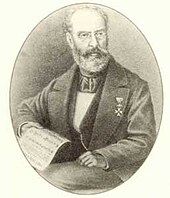
While much of present-day Greece was under Ottoman rule, the Ionian Islands enjoyed a Golden Age in music and opera. Corfu was the capital city of a Venetian protectorate and it benefited from a unique musical and theatrical heritage. Then in the 19th century, as a British Protectorate, Corfu developed a musical heritage of its own and which constitutes the nucleus of modern Greek musical history. Until the early 18th century, musical life took place in city and village squares, with performances of straight or musical comedies – known as Momaries or Bobaries. From 1720, Corfu became the possessor of the first theatre in post-1452 Greece. It was the Teatro San Giacomo (now the City Hall) named after the nearby Roman Catholic cathedral (completed in 1691).[150]
The island was also the center of the Ionian School of music, the musical production of a group of Heptanesian composers, whose heyday was from the early 19th century till approximately the 1950s. It was the first school of classical music in Greece and it was a heavy influence for the later Greek music scene, after the independence.
The three Philharmonics

Corfu's Philharmonic Societies provide free instruction in music, and continue to attract young recruits. There are nineteen such marching wind bands throughout the island.
Corfu city is home to the three most prestigious bands – in order of seniority:
- the Philharmonic Society of Corfu use dark blue uniforms with dark red accents, and blue and red helmet plumes. It is usually called the Old Philharmonic or simply the Paliá ("Old"). Founded 12 September 1840.
- the Mantzaros Philharmonic Society use blue uniforms with blue and white helmet plumes. It is commonly called the Néa ("New"). Founded 25 October 1890.
- the Capodistria Philharmonic Union use bright red and black uniforms and plumes. It is commonly called the Cónte Capodístria or simply the Cónte ("Count"). It is the juniormost of the three (founded 18 April 1980).
All three maintain two major bands each, the main marching bands that can field up to 200 musicians on grand occasions, and the 60-strong student bandinas meant for lighter fare and on-the-job training.
The bands give regular summer weekend promenade concerts at the Spianada Green "pálko", and have a prominent part in the yearly Holy Week ceremonies.
Ionian University music department

Since the early 1990s a music department has been established at the
Theatres and operatic tradition
Teatro di San Giacomo

Under
The first opera to be performed in the San Giacomo was in 1733 ("
Municipal Theatre of Corfu
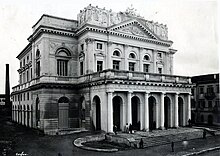
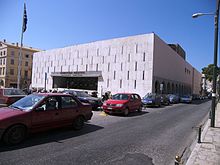
The Municipal Theatre of Corfu (Greek: Δημοτικό Θέατρο Κέρκυρας) was the main theatre and opera house in Corfu.[153] Opened in 1902, the theatre was the successor of Nobile Teatro di San Giacomo di Corfù which became the Corfu city hall. It was destroyed during a Luftwaffe aerial bombardment in 1943.[153]
During its 41-year history, it was one of the premier theatres and opera houses in Greece, and as the first theatre in Southeastern Europe,[153] it contributed to the arts and to the history of the Balkans and of Europe.[154][153][155] The archives of the theatre, including the historical San Giacomo archives, all valuables and art were destroyed in the Luftwaffe bombing with the sole exception of the stage curtain, which was not in the premises the night of the bombing and thus escaped harm; among the losses are believed to have been numerous manuscripts of the work of Spyridon Xyndas, composer of the first opera in Greek.[153]
Festivities
Easter
On
On Holy Saturday morning, the three city bands again take part in the Epitaph processions of St. Spyridon Cathedral in procession with the Saint's relics.[156] At this point the bands play different funeral marches, with the Mantzaros playing Miccheli's Calde Lacrime, the Palia playing Marcia Funebre from Faccio's Amleto, and the Capodistria playing the Funeral March from Beethoven's Eroica. This custom dates from the 19th century, when colonial administrators banned the participation of the British garrison band in the traditional Holy Friday funeral cortege. The defiant Corfiotes held the litany the following morning, and paraded the relics of St. Spyridon too, so that the administrators would not dare intervene.
The litany is followed , at exactly 11:00 AM, the celebration of the "Early Resurrection"; balconies in the old city are decked in bright red cloth, and Corfiotes throw down large clay pots (the bótides, μπότηδες) full of water to smash on the street pavement, especially in wider areas of
Once the bótides commotion is over, the three bands parade the clay-strewn streets playing the famous "Graikoí" festive march.[157] The march, which functions as the anthem of the island, was composed during the period of Venetian rule, and its lyrics include: "Greeks, never fear, we are all enslaved: you to the Turks, we to the Venetians, but one day we shall all be free".[citation needed]
Another venerable Corfu tradition is known as the Carnival or Ta Karnavalia. Venetian in origin, festivities include a parade featuring the main attraction of Karnavalos, a rather grotesque figure with a large head and smiling face, leading a diverse procession of colourful floats.[158] Corfiots, young and old, dress up in colourful costumes and follow the parade, spilling out into the area's narrow streets (kantounia) and spreading the festivities across the city,[158] dancing and socialising. At night, dance and costume parties are traditional.[158]
Cultural depictions
In myth
- It is in Corfu that Heraclids, also a son of Heracles).[159]
- Corfu marks the Argonauts' refuge from the avenging Colchic fleet, after their seizure of the Golden Fleece.[71]
- In the mythical sea adventure of Phaeacians, (Phaiakes) wherein Odysseus (Ulysses) meets Nausica, the daughter of King Alkinoos. The bay of Palaiokastritsa is considered to be the place where Odysseus disembarked.[160]
In literature
- British naturalist Birds, Beasts and Relatives; and The Garden of the Gods. His brother, literary author Lawrence Durrell, also wrote a volume about Corfu: Prospero's Cell: A Guide to the Landscape and Manners of the Island of Corcyra (Corfu).
- Mary Stewart's novel This Rough Magic is set in Corfu.
- Shakespeare's final play, The Tempest, is often said to have been based on Corfu.
- Letitia Landon twice wrote of Corfu as an island paradise, the first poetical illustration appeared in Fisher's Drawing Room Scrap Book, 1835, to a picture by Thomas Allom[161] and the second in that for 1838, to a picture by Charles Bentley.[162](Corfu and Manduchio form Mount Olivet). A third poetical illustration of hers
 Strada Reale.—Corfu., to an engraving of a painting by Samuel Prout was published in the Scrap Book for 1837.[163]
Strada Reale.—Corfu., to an engraving of a painting by Samuel Prout was published in the Scrap Book for 1837.[163] - Humbert Humbert's first love, Annabel Leigh, is said to have died of typhus in Corfu in a scene of Vladimir Nabokov's Lolita.
- Albert Cohen wrote three books which are partially or entirely set in Corfu. They are: Mangeclous, Les Valeureux, and Belle du Seigneur. Cohen himself was born on the island.
- Voltaire references two monks from Corfu in Chapter XXVIII of Candide
In film
- Corfu was one of the main locations featured in the 1970 film The Executioner starring George Peppard and Joan Collins.[164]
- Corfu was one of the settings of The Burglars, a 1971 film starring Jean-Paul Belmondo and Omar Sharif.
- The Countess of Corfu (Greek: Η Κόμησσα Της Κέρκυρας), a 1972 film starring Rena Vlahopoulou and Alekos Alexandrakis, was filmed in Corfu.
- Much of the 1978 Billy Wilder film Fedora is set in Corfu and filmed on location.
- Some scenes of the 1978 film The Greek Tycoon starring Anthony Quinn and Jacqueline Bisset were filmed in Corfu.[165][166] The film is a fictionalized account of the life of the Greek shipping magnate, Aristotle Onassis.
- The 1980 French comedy Corfu Town.[167]
- The 1981 James Bond movie For Your Eyes Only has a number of scenes filmed in Corfu. The most memorable scene of the film to be bound with the island is of the underwater ancient Greek temple, with a huge turtle swimming in front of the camera; a casino scene was also filmed at the Achilleion.[168] Other scenes filmed here include those tracing 'Melina' and James' walk through the city's streets, and Melina being greeted by Bond at Pontikonisi island. A major action element was filmed on the largest sandy beach on the island, Issos Beach in Agios Georgios South, involving a beach buggy chase along the dunes. The film's scene depicting a Greek wedding was filmed at the Bouas-Danilia traditional village (Μπούας Δανίλια παραδοσιακό χωριό).[168] Action scenes were also filmed at Neo Frourio.[169]
- The 1984 Greek film "Η Τιμή της Αγάπης" (The Price of Love), directed by Tonia Marketaki is a tragic love story taking place in Corfu. It is based on the novel Honour and Money by Konstantinos Theotokis.[170]
- Corfu is also the setting of a 1987 BBC TV series version, and a 2005 BBC movie version, of My Family and Other Animals, Gerald Durrell's book about his childhood in Corfu in the late 1930s
- Kaiser Wilhelm II.[171][172] Harrison concludes his 1992 film-poem by making a proposal that in the 1994 European Union summit in Corfu, Heine's statue be returned to Corfu on time to preside over the new Europe so that EU can keep its eyes open and not turn to stone from the Gorgon's gaze.[172][173][174]
- ITV aired a TV series named The Durrells in Corfu in April 2016 and ultimately lasting four seasons, concluding in May 2019. It was a biographical series detailing Gerald Durrell's childhood on Corfu.
In popular culture
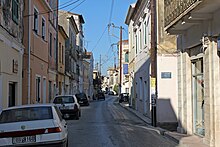
Corfu is one of the locations in the legend of Simon and Milo, where Simon falls in love temporarily. It is the setting of the 1998 song "Mediterranean Lady" by
Tourism

Corfiotes have a long history of hospitality to foreign residents and visitors, typified in the 20th century by
At the other end of the island, the southern resort of Kavos also provides tourist facilities.
St George South to the west boasts the largest sandy beach on the island coupled with a selection of all-inclusive package hotels and traditional corfiot villas and flats. The Korission lake nature reserve also provides a stopover for European birds migrating south.
Up until the early 20th century, it was mainly visited by the European royals and elites, including Emperor
Transport

The island is linked by two highways: GR-24 in the northwest and GR-25 in the south.
- Greek National Road 24, Cen., NW, Corfu – Palaiokastritsa
- Greek National Road 25, Cen., S, SE, Corfu – Lefkimi
Corfu has ferry services both by traditional ferries to Gaios in the island of
The
The buses to the main places on the island run about six times a day between the city and Glyfada, Sidari, Paleokastritsa, Roda and Acharavi, Lefkimmi, Lefkimmi and Piri. Other coaches drive up to twice a day to Athens and Thessaloniki. City buses run through the city to the Airport, Achilleion, Gouvia, Afra, Pelekas and some other places of interest.
The
Economy

Corfu is mostly planted with olive groves and vineyards and has been producing olive oil and wine since antiquity. The main wine grape varietals found in Corfu are the indigenous white Kakotrýgēs and red Petrokóritho, the
Modern times have seen the introduction of specialist cultivation supported by the mild climate, like the
Local culinary specialties include
The island has again become an important port of call and has a considerable trade in olive oil.[15] In earlier times there was a great export of citron, which was cultivated here, including for ritual use in the Jewish community during the Sukkot holiday.
International relations
Twin towns – sister cities
Partner cities
Notable people
Ancient
- Nausicaa daughter of King Alcinous
- Arsenius (10th century), saint
- Peithias, leader during the Peleponnesian War
- Philiscus, tragic poet, born in Corfu
- Ptolichus (5th century BC), sculptor
- Saint Philomena(AD 291–304), virgin and martyr
Modern
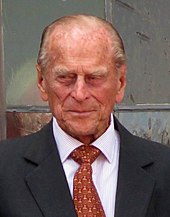
- , born in Corfu
- M.B.E., distinguished Corfiote magazine publisher and cultural figure who influenced the literary and cultural life of post-war Corfu
- Panos Aravantinos, artist, born in Corfu
- Felice Beato, 19th-century photographer, born in Corfu
- Giacomo Casanova, lived on the island as an officer of the Venetian army
- Albert Cohen, Swiss-French author, born in Corfu
- Ian Hamilton, Military Officer, Led the 1915 Gallipoli Landings, born in Corfu
- Haim Corfu, Israeli politician, was born in Jerusalem, his family name testifying to his family's origin
- Mathew Devaris, scholar, born in Corfu
- Tommaso Diplovataccio, Greco-Italian jurist, publisher and politician, born in Corfu
- Eleni Doika, Greek Olympic gymnast, born in Corfu
- Panagiotis Doxaras, painter, pioneer of the Heptanese School of painting, worked and died in Corfu
- My Family And Other Animals, Birds, Beasts, and Relatives, and The Garden of the Gods, making the island famous among the readers, books translated in many languages.
- Lawrence Durrell also lived in Corfu for some years and Lawrence wrote, among several other books on Greece, Prospero's Cell: A Guide to the Landscape and Manners of the Island of Corcyra
- Elisabeth of Bavaria("Sissi"), Empress of Austria, built Achilleion as summer palace
- Greek military junta of 1967–1974, born in Corfu
- Angela Gerekou, actress, singer and politician, born in Corfu, wife of Tolis Voskopoulos
- Spyridon Gianniotis, Olympic silver medalist in swimming, raised in Corfu with father from Corfu
- Spyros Gogolos, footballer, born in Corfu
- Angelos Grammenos, actor
- Augustinos Kapodistrias, younger brother of Ioannis Kapodistrias, soldier and politician. He was born in Corfu.[182]
- Ioannis Kapodistrias, first Governor of Greece, born in Corfu
- Maria Desylla-Kapodistria, relative of Ioannis Kapodistrias, mayor of Corfu and first female mayor of Greece[88]
- Kore. Ydro., musical group, formed and based in Corfu
- Spyridon Lambros, history professor and former Prime Minister of Greece, born in Corfu
- Petros Lantzas, rebel, spy and privateer
- Vicky Leandros, international pop star, born in Corfu
- Andreas Mandelis, expert on photonics, member of the Canadian Academy of Engineering. Awarded the 2014 Killam Prize
- Nikolaos Mantzaros, composer, born in Corfu
- Aristedes Metallinos, sculptor
- Margarita Miniati (1821–1897), Greek scholar and writer, born in Corfu
- Andreas Moustoxydis, historian and philologist, born in Corfu
- Vangelis Petsalis, classical musician and composer, born in Corfu
- (1921–2021), born Prince Philippos of Greece and Denmark, in Corfu
- Petros Brailas Armenis, philosopher, politician, diplomat and former owner of the predecessor of the Achilleionpalace, born in Corfu
- Yvette Manessis Corporon - Greek American journalist and author
- Iakovos Polylas, first published of Dionysios Solomos, born in Corfu
- Empress of India
- Alfredo Ragona (born 1922), Greek footballer
- Georgios Rallis (1918–2006), prime minister, son of Ioannis Rallis and Zaira, daughter of George Theotoki
- Alexander Rossi, artist, born in Corfu
- Sakis Rouvas, singer and athlete, born in Corfu
- Reichsgrafsuccessfully defended the island against the Ottoman Turks during the siege of 1716 as leader of the Venetian forces in Corfu
- Spyridon Samaras, composer, born in Corfu
- Nikolaos Sophianos, humanist and cartographer, born in Corfu
- Carl Ludwig Sprenger, German botanist, lived in Corfu
- Theodore Stephanides, poet, author, doctor and naturalist, born in Corfu
- Georgios Theotokis, former Prime Minister of Greece, born in Corfu
- Ioannis Theotokis, politician, born in Corfu
- Nikephoros Theotokis (1732–1800), Greek educator and Russian archbishop, born in Corfu
- Antonio Vivaldi composer. In 1716, on commission by the republic of Venice, created the oratorio Juditha triumphans to commemorate victory over the Turks during the great siege of 1716.
- Rena Vlahopoulou, actress and singer, born in Corfu
- Eugenios Voulgaris, scholar, born in Corfu
- Gaetano Giuffrè, composer, Maestro, born in Corfu
- Sotirios Voulgaris (1857–1932), cosmetologist, founder of the Bulgari jewellery store that later became the famous Bulgari company
- Spyridon Xyndas (1812–1896), composer and musician, born in Corfu
- Kaiser Wilhelm II of Germany, bought Achilleion after Sissi's death
- Greek scholar, geographer and lawyer born in Corfu[183]
- Spiro Çomora, famous Albanian dramatist
- Anthony Stevens, Jungian analyst, lived in Corfu
Gallery
-
Cape Drastis at the northwest tip of Corfu island
-
Chalikiopoulou Lagoon (or Lake Chalikiopoulou), south of Corfu town
-
Old tower, Corfu town
-
Panorama of the Old Town of Corfu
-
Venetian quarter, Corfu town
-
Odós Ipeirou in Corfu old town
-
Historic building in Evgeniou Voulgareos street
-
View of St. George's Temple at the Old Fortress
-
Gardens of Achilleion
-
Statues at the Achilleion terrace
-
Villa Rossa, landmark of Corfu city
-
Pelekas village
-
Kaiser's Bridge in Corfu c. 1918
-
Workers on Corfu. The image shows the Old Fortress. First World War
See also
- Aspioti-ELKA
- Cuisine of the Ionian islands
- Heptanese School (painting)
- Hercules (vehicles)
- Korčula
- Music of the Heptanese
- Temple of Hera, Mon Repos
Explanatory notes
- Latin: Corcyra.
Citations
- ^ a b Packe, Cathy (22 November 2016). "The Complete Guide To: Corfu". The Independent. Archived from the original on 27 April 2021. Retrieved 27 August 2021.
- ISBN 9781872876207.
Corfu is one of the most northern isles in Greece and also the most westerly, apart from three of its own small satellite isles...
- ^ a b https://corfutvnews.gr/diaspasi-deite-tin-tropologia/ (in Greek)
- ^ "ΦΕΚ B 1292/2010, Kallikratis reform municipalities" (in Greek). Government Gazette.
- ^ Thucydides, History of the Peloponnesian War 1.36.3
- ^ a b c d "Corfu City Hall website". City of Corfu. Archived from the original on 6 January 2008.
In literature, apart from the Homeric name Scheria, we meet various other names for the island, like Drepanë or Arpi, Makris, Cassopaea, Argos, Keravnia, Phaeacia, Corkyra or Kerkyra (in Doric), Gorgo or Gorgyra and much later the medieval names Corypho or Corfoi, because of the two characteristic rock-peaks of the Old Fortress of Corfu.
- ^ Johann Georg Keyssler (1760). Travels Through Germany, Bohemia, Hungary, Switzerland, Italy, and Lorrain: Giving a True and Just Description of the Present State of Those Countries …. G. Keith. p. 54. Retrieved 6 July 2013.
Corfu is not only a bulwark to the Venetians against the attack of a foreign enemy,... [...] ....and, since count Schulenburg caused several fortifications to be added to it, it may justly be looked upon as one of the strongest places in Europe.
- ^ "on UNESCO World Heritage List". BBC News. 28 June 2007. Retrieved 29 June 2009.
- ^ "UNESCO Advisory Body ICOMOS report on Corfu History" (PDF). Retrieved 3 July 2007.
- ^ "Old Town of Corfu on UNESCO website retrieved 3 July 2007". Whc.unesco.org. Retrieved 29 June 2009.
- ^ ANDREW MARSHALL IN CORFU (24 June 1994). "European Union Summit: Corfu summiteers ready to fudge key EU decision". The Independent.
- ^ Duncan Garwood, Mediterranean Europe, 2009
- ^ Russell King, John Connell, Small worlds, global lives: islands and migration, 1999
- ^ a b c "Korkyra". Theoi.com. Greek Mythology Encyclopedia. Retrieved 29 June 2009.
- ^ a b c d e f g h i j k l m n o p q r s t One or more of the preceding sentences incorporates text from a publication now in the public domain: Gardner, Ernest Arthur; Caspari, Maximillian Otto Bismark (1911). "Corfu". In Chisholm, Hugh (ed.). Encyclopædia Britannica. Vol. 7 (11th ed.). Cambridge University Press. pp. 145–146.
- ^ "Population & housing census 2001 (incl. area and average elevation)" (PDF) (in Greek). National Statistical Service of Greece. Archived from the original (PDF) on 21 September 2015.
- ^ a b "Corfu honored with a new museum". Koine.terapad.com. Retrieved 29 June 2009.
- ^ a b "Lazaretto Islet". Travel-to-Corfu.com. Retrieved 29 June 2009.
- ^ "Corfu climate: Average Temperature, weather by month, Corfu water temperature - Climate-Data.org". en.climate-data.org. Retrieved 21 March 2023.
- ^ "Kekira Climate extremes 1991-present". Retrieved 1 March 2023.
- ^ "Mean Corfu Climatic Averages". Hellenic National Meteorological Service. Archived from the original on 24 January 2015. Retrieved 1 March 2015.
- ^ "Kekira Climate Normals 1961–1990". National Oceanic and Atmospheric Administration. Retrieved 1 March 2015.
- ^ "Mean Corfu Climatic Averages". Hellenic National Meteorological Service. Archived from the original on 24 January 2015. Retrieved 1 March 2015.
- ^ Panitsa, M. & E. Iliadou 2013: FLORA AND PHYTOGEOGRAPHY OF THE IONIAN ISLANDS (Greece). 2nd Botanical Conference in Menorca.
- ^ Gasteratos, I. unpublished data.
- ^ Γαστεράτος Ι. 2020: Τα Πουλιά των Προστατευόμενων Περιοχών της Κέρκυρας. Διημερίδα 'Οι Προστατευόμενες Περιοχές του Φορέα Διαχείρισης Καλαμά – Αχέροντα – Κέρκυρας' 24-25/1/2020.
- ^ Γαστεράτος, Ι. 2019: Αλλαγές σε οικοσυστήματα της Κέρκυρας. Κάποια παραδείγματα. Επιστημονικό – Εκπαιδευτικό Συνέδριο 'Βιοποικιλότητα – Κλιματική αλλαγή και επιπτώσεις της σε νησιωτικά οικοσυστήματα.' Κέρκυρα 6-8/3/2020.
- ^ Frantzis, A. 2009: Cetaceans in Greece: Present status of knowledge. Initiative for the Conservation of Cetaceans in Greece.
- ^ Ruiz-Olmo, J. 2006: The Otter (Lutra lutra L.) on Corfu Island (Greece): Situation in 2006. IUCN Otter Spec. Group Bull. 23: 17-25.
- ^ a b c d e Stille, M., Gasteratos, I. & B. Stille 2021: Larger mammals of Corfu, Ionian Islands, Greece – status and potential threats. Russian Journal of Theriology 20(2): 204-214.
- ^ Roberts, G. 2022: Otter survey of the island of Corfu 2021. OTTER, Journal of the International Otter Survival Fund 2022: 39-42.
- ^ Masseti, M. (2010). "Homeless mammals from the Ionian and Aegean islands". Bonn Zoological Bulletin. 57 (2): 367–373.
- ^ Gasteratos, I. & Z. Fondoulakou 2018: The presence and the extinction of the Golden Jackal Canis aureus from the Island of Corfu, northwestern Greece. Conference: 2nd International Jackal Symposium: Marathon, Greece.
- ^ Hanák, V., Benda, P., Ruedi, M., Horacek, I. & T.S. Sofianidou 2001: Bats (Mammalia: Chiroptera) of Eastern Mediterranean. Part 2. New records and review of distribution of bats in Greece. Acta Societatis Zoologicae Bohemicae 65: 279-346.
- ^ Life GRECABAT: Κατάλογος σπηλαίων με εποχές παρουσίας σημαντικών αποικιών (accessed in: 28/4/2021).
- ^ Stille, M., Gasteratos, I. & B. Stille 2021: Alien and invasive terrestrial vertebrate species on Corfu, Ionian Islands, Greece. Journal of Vertebrate Biology 70(1): 1-13.
- ^ Stille, B. & M. Stille 2017: The Herpetofauna of Corfu and adjacent Islands.
- ^ a b c "About the Corfu Butterfly Conservation". Corfu Butterfly Conservation. Retrieved 11 March 2022.
- ^ Danahar G. W. (2020) Corfiot Butterflies – a contemporary perspective and global context, European Butterflies, Issue 3, pages 6-7.
- ^ Danahar G. W. (2022) Corfu Butterfly Conservation (CBC) – our first year of survey work - 2021, European Butterflies, Issue 5, pages 18 - 21.
- ^ "Palaeolexicon, Word study tool of ancient languages".
- ^ Strab. vi. p. 407
- ^ W.H. Race, Apollonius Rhodius: Argonautica, Loeb Classical Library (2008), p. 409 n. 125–27; verses 4.982–992
- ISBN 978-90-5972-344-3. Retrieved 11 November 2012.
- ^ Wilkes 1996, pp. 100–101, 111.
- ^ Šašel Kos 2005, pp. 183.
- ^ Barnett 2016, pp. 72–73.
- ^ Thucydides. "The Revolution in Corcyra." c. 400 BCE. Reprinted in Rogers, Perry. Aspects of Western Civilization. pp. 76–78. Pearson: Upper Saddle River. 2011.
- ^ The Oxford Classical Dictionary, Oxford University Press, Oxford: 1992.
- ^ Leontsini 2014, pp. 26–27.
- ^ Leontsini 2014, pp. 28–29.
- ^ Leontsini 2014, pp. 32–33.
- ^ Leontsini 2014, pp. 30–31.
- ^ Leontsini 2014, pp. 31–32, 33–34.
- ^ a b Leontsini 2014, p. 35.
- ^ Leontsini 2014, p. 34.
- ^ Leontsini 2014, pp. 36–38.
- ISBN 978-1-107-60474-2.
- ^ Hazard, H. W. (2017). A History of the Crusades, Volume 2: The Later Crusades, 1189-1311. USA: University of Pennsylvania Press, Incorporated, p. 260
- ISBN 9780819564887.
- ISBN 9780631196051.
- ^ a b The Scots Magazine and Edinburgh Literary Miscellany. Vol. 71. Archibald Constable. 1809. p. 916. Retrieved 6 July 2013.
Under the Venetians, in the middle ages, and down even to the seventeenth century, Corfu was esteemed the advanced bastion and bulwark of the Christian states, against the Ottoman power, when the Solymans and the Sclims menaced ...
- ISBN 978-0-307-38772-1. Retrieved 6 July 2013.
For Venice only a single bulwark remained: Corfu. The army that, early in 1716, the Grand Vizir flung against the citadel of Corfu consisted of 30,000 infantry and some 3,000 horse.
- ^ Elizabeth Mary Leveson-Gower Grosvenor Westminster (2d marchioness of) (1842). Narrative of a Yacht Voyage in the Mediterranean: During 1840–41. J. Murray. p. 250. Retrieved 6 July 2013.
Corfu thus became a strong bulwark against the Turks, whose frequent attacks were successfully repulsed. In 1716 it was besieged for forty-two days by a formidable Ottoman army and fleet, and several daring attempts were made to storm ...
{{cite book}}: CS1 maint: numeric names: authors list (link) - ^ Sir Richard Phillips (1822). New Voyages and Travels: Consisting of Originals, Translations, and Abridgments; with Index and Historical Preface. C. Wiley. p. 63. Retrieved 6 July 2013.
The town of Corfu, the bulwark of Italy and of the east, is Covered in all directions, towards the sea and land,
- ^ John Knox (1767). A New Collection of Voyages, Discoveries and Travels: Containing Whatever is Worthy of Notice, in Europe, Asia, Africa and America. J. Knox. p. 203. Retrieved 6 July 2013.
Some pieces by Castiglione, deserved particular notice, together with the last siege, and the new fortifications of Corfu, which is not only painted on a picture, but curiously modelled in wood. Corfu is not only a bulwark to the Venetians, against ...
- ISBN 978-0-87169-192-7. Retrieved 6 July 2013.
Thus the important stronghold of Corfu was protected (according to a dispatch of Antonio Priuli, proveditor generale da ... Morea would prove to be, for they were bulwarks against the Turks' intrusion into the Adriatic.17 Corfu was apparently ...
- ^ Henry Jervis-White-Jervis (1852). History of the island of Corfú and of the republic of the Ionian Islands. Colburn and co. p. 126. Retrieved 6 July 2013.
...sister of Sixtus-Quintus, to the Book of Gold, the Holy Father having expressed his gratitude, the Venetians represented to him that the protection of Corfu and Candia, which were the two bulwarks of Christianity, cost them more than 500,000 ...
- ^ "The Gulf of Venice runs for 800 mi (1,287 kilometres) between Italy and Esclavonia, and at the end of it is the island of Corfu, which the Venetians call their door, although Venice is in fact 800 mi (1,287 kilometres) away." (Pedro Tafur in 1436, Andanças e viajes).
- ISBN 1-56731-016-8
- ^ a b c d e f g h i j "History of Corfu". Corfuweb.gr. Archived from the original on 11 April 2009. Retrieved 29 June 2009.
- ^ "History of Corfu from xenos website". Archived from the original on 14 August 2007.
- ISBN 978-0-521-47033-9. Retrieved 6 July 2013.
The Ottomans were a major and expanding presence in Europe, Asia, and Africa. ... The knights, their fortifications strengthened by bastions, resisted assaults and bombardment before accepting ... Ottoman naval pressure on Europe increased in the Mediterranean, with sieges of Corfu in 1537 (map 2) and Reggio in 1543.
- ^ ca:Història de Corfú
- ^ "Serbs in Corfu website". Archived from the original on 28 September 2007.
- ^ a b c d e f History of Corfu from Corfu City Hall website Archived 6 January 2008 at the Wayback Machine
- ^ a b United States Holocaust Memorial Museum Archived 12 March 2007 at the Wayback Machine on the Holocaust in Corfu. Also contains information about the Nazi collaborator mayor Kollas.
- ^ From the interview of a survivor in the film "Shoah"
- ^ a b "Central Jewish Council of Greece website". Kis.gr. Archived from the original on 17 October 2007. Retrieved 29 June 2009.
- ^ United States Holocaust Memorial Museum Archived 8 December 2012 at the Wayback Machine: "[...]two hundred of the 2,000 Corfu Jews found sanctuary with Christian families[...]"
- ^ BBC WW2 People's War Quote: "By the time I got back to camp the troop had returned from Corfu full of stories about the wonderful reception they’d had from the locals as the liberators of the island." Bill Sanderson's Wartime Experiences -Part 4 – 40 Commando by Bill Sanderson (junior) Bill Sanderson's Wartime Experiences -Part 4 – 40 Commando by Bill Sanderson (junior) Retrieved 31 July 2008
- ^ S2CID 147423999.
- ^ Corfu Channel Incident Records of the Admiralty, Naval Forces, Royal Marines, Coastguard, and related bodies U.K. Retrieved 31 July 2008.
- JSTOR 1226351.
- ISBN 9780815340577.
- ^ "World Court Gets Albanian Dispute". The New York Times. 10 April 1947. pp. 1, 10.
- ^ Anderson, David (10 April 1949). "World Court Finds Albania Liable in Corfu Mining of 2 British Ships". The New York Times. pp. 1, 15.
- ^ a b Municipality of Corfu from the Internet archive Quote: "In the elections of 1954 Stamatios Desillas was elected Mayor for a second term and remained in office until his death, Christmas Day 1955. Soon after a bye-election took place in Corfu in which the widow of the deceased Maria Desilla – Kapodistria, was elected Mayor with 5,365 votes in a total of 10,207. Maria Desilla became Mayor of Corfu on 15 April 1956 until 9 May 1959. She was the first female Mayor in Greece."
- ^ "Corfu General Hospital". Archived from the original on 25 December 2007.
- ^ "Corfu Radio Station History". Tvradio.ert.gr. Archived from the original on 2 April 2009. Retrieved 29 June 2009.
- ^ Alfa History Archived 23 July 2011 at the Wayback Machine Quote:1995 The first in Corfu ISP by Alfa and Forthnet.
- ^ R. Winkes (editor), Kerkyra. Artifacts from the Palaiopolis, Providence 2004.
- ^ ISBN 978-0-521-49752-7. Retrieved 4 May 2013.
After the purchase of the 'Achilleion', Kekule was invited by the Kaiser to go to Corfu to provide advice on the positioning of the ... 94 Without a doubt, Wilhelm's lifelong obsession with the statue of the Gorgon unearthed in Corfu stems from the ...
- ISBN 978-0-470-52664-4. Retrieved 4 May 2013.
Achilles that the Kaiser had inscribed, to the Greatest Greek from the Greatest German, a sentiment removed after World War II.
- ISBN 978-1-55859-845-4. Retrieved 4 May 2013.
Although subsequently demolished in 1944 to allow the passage of a huge German coastal gun beneath, the locality still bears the name "Kaiser's Bridge".
- ^ Corfu map Archived 12 October 2007 at the Wayback Machine: The bridge was destroyed during a German attack in World War II. The remains can still be seen today.
- ^ Corfu Life UK Archived 4 October 2008 at the Wayback Machine Quote: "The French were the ones who turned the Spianada into a public square and park – one of the biggest in Europe"
- ^ Brohure of Kerkyra Archived 3 October 2008 at the Wayback Machine Quote: "SOCCER The tournament will start on Wednesday 04 of July An Open Ceremony and a parade of all the teams will take place in the biggest square in the Balkansand one of the most impressive ones in the whole continent, to the square Spianada itself which is constructed similarlyto the Royal Gardens of Europe."
- ISBN 9789608403000.
The Palace of St. Michael and St. George (Plate III), which is generally considered the finest of the British buildings in ... seat of the Order of St. Michael and St. George which had been instituted in 1818 to honour distinguished British and local ...
- ISBN 978-0-313-23897-0.
- ^ S2CID 193469029.
- ^ S2CID 191378100.
This is the only Greek Doric building that is known to have had no frieze.
(subscription required) - ISBN 978-0-8196-0283-1.
- ^ Acta Ad Archaeologiam Et Artium Historiam Pertinentia: 4o. "L'Erma" di Bretschneider. 1978. p. 47.
In this respect it is surpassed only by the perhaps slightly later temple at Kardaki on Corfu (*), where the frieze was completely omitted. This is nothing but the logical consequence of the tendencies from the early Sicilian temples, where the ties...
- ISBN 978-0-521-09452-8.
- ISBN 978-0-19-530082-6.
A second temple, at Kardaki on the east side of Corfu town, was also Doric but had 6 by 12 columns, and its cella had neither false porch nor adyton. The columns are widely spaced, and the unusual absence of a triglyph and metope frieze may be explained by the influence of Ionic forms.
- ^ a b c Darling 2004, pp. 184–186.
- ^ a b Cruickshank 2000, Chapter One: "Temple of Artemis, Corcyra", p. 18: "The island of Corfu, to the northwest of present-day Greece, off the coast of Albania, was an early colony of the city of Corinth and was under Corinthian control when its Temple of Artemis was constructed. A milestone in Greek architecture, this was the first building that was truly Doric. Many if not all of its Doric characteristics had appeared in earlier structures but here they were used for the first time as an ensemble."
- ^ Gates 2003, pp. 211–213.
- ^ Raaflaub & van Wees 2009, Chapter 10: Sanne Houby-Nielsen, "Attica: A View from the Sea", p. 203.
- ISBN 978-1-4443-3599-6.
- ISBN 978-0-521-85797-0.
- ^ "Philip Sapirstein: "el templo de Hera fue construido originalmente con la columnata de piedra"". mediterraneoantiguo.com. 16 September 2016.
- ^ a b Gardner, Percy (1896). Sculptured Tombs of Hellas. London: Macmillan and Company, Limited. p. 200.
- ISBN 978-88-283-2151-4. Archived from the originalon 26 June 2019.
- ^ a b c d "Funerary Archaic Lion". Archaeological Museum of Corfu. Archived from the original on 14 May 2019. Retrieved 14 May 2019.
- ISBN 978-1-910589-58-8.
- ISBN 9780890090893.
This lion was found near the tomb of Menekrates in the necropolis of ancient Kerkyra (modern Corfu). Menekrates was a Lokrian, the proxenos of the people of Kerkyra, according to a metric inscription on the grave monument.
- ^ "Το μνημείο του Μενεκράτη". Odysseus. Archived from the original on 5 November 2019. Retrieved 14 May 2019.
- ^ "St. George Article". Archived from the original on 11 March 2007.
- ISBN 9789608403000.
The New Fortress was built on the hill of St. Mark between 1572 and 1645, the military engineer ...
- ^ ISBN 9789608403000.
On a precipitous rocky peak dominating a wide range of coastline around Palaeokastritsa stand the crumbling walls and battlements of the twelfth-century Byzantine Fortress of Angelokastro, not far from the village of Krini. (p. 163) [...] After a siege lasting a year the invaders were finally driven away by the defenders of the fortress who were helped by the inhabitants of the neighbouring villages. Again, during the first great siege of Corfu by the Turks in 1537, Angelocastro successfully resisted attack. About 3,000 villagers had sought refuge within the fortress to escape the fate of the inhabitants of other parts of the island who were ... In 1571, when they once more invaded Corfu, the Ottomans again unsuccessfully attacked, Angelocastro, where 4,000 people had taken refuge. During the second great siege of the city by the Ottomans in 1716, Angelokastro once again served as a refuge for the...During the course of the centuries Angelocastro played an important part in the defence of the island. In 1403 a force of Genoese soldiers, under the command of the French condottiere Boucicaut, landed at Palaeokastritsa and attacked ... The fortress existed in 1272 when it was formally taken over by the Italian Giordano di San Felice in the name of the Angevin rulers of Naples, who held the island of Corfu from 1267 to 1386. (p. 164)[...]...Angelocastro was probably built during the reign of the Byzantine Emperor Manuel Comnenos (1143 - 1 180).(p. 164)[...]This was used as a hermitage and was converted into a chapel, probably around the end of the eighteenth century (p. 165)[...]From the top of Angelocastro the view sweeps far and wide over the hills across the breadth of Corfu, to the town, the Eastern Channel and the mountains on the mainland, over a sheer drop of a thousand feet to the sea below (p.325)
- ^ Michaēl S. Kordōsēs (1981). Symvolē stēn historia kai topographia tēs periochēs Korinthou stous mesous chronous. Vivliopōleio D.N. Karavia. p. 140. Retrieved 19 September 2013.
Ή ύπαρξη βυζαντινών έρειπίων στή θέση Πατίμα δείχνει πιθανότατα ότι στό σημείο αύτό ύπήρχε βυζαντινός οικισμός. Δέν άποκλείεται, σέ δυσκολότερα χρόνια, ό πληθυσμός νά μετοίκησε άπό τή θέση αύτήστσν οχυρωμένο λόφο. Εκτός άπό τό βυζαντινό φρούριο, στήν περιοχή τοϋ Άγγελοκάστρου παρουσιάζουν ένδιαφέρον καί δυό παλιές έκ- κλησίες, πού ...Ο Buchon, που επισκέφθηκε το καστρο, υποθέτει οτι χτιστηκε ατα τελη του ΙΒ' αιώνα από καποιο μελος της οικογενειας των Αγγελων Κομνηνων, σε μια ταραγμένη εποχή που ευνοουσε προσωπα με κυρος να γινονται ανεξαρτητα απο το κεντρο. Τα τειχη του, γραφει, μαρτυρουν βιαστικη κατασκευή.
- ISBN 978-1-118-20577-8. Retrieved 11 February 2013.
- ISBN 9789608403000. Retrieved 6 April 2013.
Again, during the first great siege of Corfu by the Turks in 1537, Angelocastro ... and After a siege lasting a year the invaders were finally driven away by the defenders of the fortress who were helped by the inhabitants of the neighbouring villages. In 1571, when they once more invaded Corfu, the Turks again unsuccessfully attacked, Angelocastro, where 4,000 people had taken refuge. During the second great siege of the city by the Turks in 1716, Angelokastro once again served...
- ISBN 978-0-7566-9434-0.
- ^ ISBN 978-1-84353-038-1.
On the other side of Mount Ayios Matheos. 2 km by road, is Gardiki Pirgos, the ruins of a thirteenth century castle built in this unlikely lowland setting by the despots of Epirus.
- ^ a b Dēmētrēs Philippidēs (1983). Greek Traditional Architecture: Eastern Aegean, Sporades-Ionian Islands. Vol. 1. Melissa. p. 222.
- ^ a b "The Old Town of Corfu Nomination for inclusion on the World Heritage List STATE PARTY Greece STATE, PROVINCE OR REGION Greece, lonian Islands Region, Corfu Prefecture NAME OF PROPERTY The Old Town of Corfu" (PDF). UNESCO. p. 29.
One thing is certain, however. The area under plough outside the walls increased, since the village communities multiplied across the entire island (if we are to judge from the Byzantine castles that have survived) in order to protect the fields. They are castles such as Kassiopi, Angelokastro and Gardiki and, of course, the Old Fortress which was the medieval town itself.
- ^ ISBN 9789608403000.
- ^ ISBN 978-0-224-01307-9.
- ^ Sotiris Voyadjis; Ασπασία Ραπτάκη (January 2007). Το κάστρο της Κασσιώπης, Κέρκυρα. Περί Ιστορίας, Τ. 5, 2007 (in Greek). Academia.edu, Ionian Society of Historical Studies: 13–34.
- ^ Συνολική Ανάδειξη Κάστρου Κασσιώπης (PDF) (in Greek). 21st Ephorate of Byzantine Antiquities of Greece. p. 384. Archived from the original (PDF) on 4 March 2016. Retrieved 8 May 2019.
- ^ "Τροποποίηση του άρθρου 1 του ν. 3852/2010" [Amendment of Article 1 of l. 3852/2010] (in Greek). Government Gazette. p. 1164.
- ^ The Literary Panorama, and National Register. Cox, Son, and Baylis. 1811. p. 561.
- ^ ISBN 978-1-4214-0298-7.
- ^ Sir John Edwin Sandys (1967). A History of Classical Scholarship: The eighteenth century in Germany, and the nineteenth century in Europe and the United States of America. Hafner Pub. Co. p. 369.
- ^ "History of the University".
- ^ "Ionian University Brochure 2017". www.ionio.gr.
- ^ "Ionian University Summer Schools". www.ionio.gr.
- ^ "Libraries and Museums from the City Hall website". Archived from the original on 6 January 2008.
- ^ Frommer's Review. "Archaeological Museum". The New York Times. Archived from the original on 11 August 2011. Retrieved 26 September 2011.
- ^ Eleni Bistika Kathimerini Article on Ioannis Kapodistrias 22 February 2008 Quote: Η γενέτειρά του Κέρκυρα, ψύχραιμη, απολαμβάνει το προνόμιο να έχει το γοητευτικό Μουσείο Καποδίστρια στη θέση Κουκουρίσα, Translation: His birthplace, Corfu, cool, enjoys the privilege to have the charming Museum Kapodistria in the location Koukourisa and εξοχική κατοικία με τον μαγευτικό κήπο της οικογενείας Καποδίστρια, που η Μαρία Δεσύλλα – Καποδίστρια δώρισε στις τρεις κερκυραϊκές εταιρείες Translation: summer residence with the enchanting garden of the Kapodistrias family, which Maria Dessyla Kapodistria donated to the three Corfiote societies
- ISBN 978-1-84614-555-1.
- ISBN 978-0-85771-828-0.
- ISBN 978-0-7495-0921-7.
A dreadful storm - coupled with the rumour that St Spyridon was threatening the Turkish army with a flaming torch - broke the Turks' ...
- ISBN 978-0-86036-025-4.
refers to the 1716 siege, when Spyridon is meant to have frightened away the Turks;
- ISBN 978-1-86011-325-3.
- ^ "Baroque Music". Archived from the original on 26 January 2010. Retrieved 20 October 2007. As far as his theatrical activities were concerned, the end of 1716 was a high point for Vivaldi. In November, he managed to have the Ospedale della Pietà perform his first great oratorio, Juditha Triumphans devicta Holofernis barbaric [sic]. This work was an allegorical description of the victory of the Venetians (the Christians) over the Turks (the barbarians) in August 1716.
- ISBN 0-7195-5375-X
- ^ a b c d e f Birth of Greek opera Paper Archived 16 October 2015 at the Wayback Machine Kostas Kardamis "San Giacomo and Greek ottocento"XI Convegno Annuale di Società Italiana di Musicologia Lecce, 22–24 October 2004
- ^ History of the theatre from Corfu cityhall
- ^ a b c d e History of the municipal theatre from Corfu cityhall
- ISBN 978-1-85109-105-8.
The addition of the Greek island of Corfu to the south, where the declaration of the Kingdom of Serbs, Croats and Slovenes was made at the municipal theatre in 1918
- ISBN 978-1-4438-6278-3.
After 1818, when an opera composed by Rossini was first scheduled for presentation in Corfu, operas by Rossini predominated over works composed by earlier or contemporary artists. This development reflected a general change in Europe, clearly illustrated by the performance of Wagner's Lohengrin in Italian for the inauguration of the new Municipal Theatre of Corfu (1902)
- ^ a b c d "Corfu city hall website on Easter festivities". Archived from the original on 14 December 2007.
- ^ "As the Old Philharmonic concludes its marching in front of their building with a hearty rendition of the Graikoí March, the New Philharmonic appears and "salutes" their rivals with yet another rendition of the same march". YouTube.
- ^ "Hercules slept with a minor goddess named Melite and she bore him a son named Hyllus (not to be confused with Hyllus, Hercules' son by Deianeira)". Marvunapp.com. Retrieved 29 June 2009.
- ^ "Mirror Newspaper Travel section". Daily Mirror. Archived from the original on 6 June 2011. Retrieved 2 April 2018.
- ^ Landon, Letitia Elizabeth (1834). "picture". Fisher's Drawing Room Scrap Book, 1835. Fisher, Son & Co. Landon, Letitia Elizabeth (1834). "poetical illustration". Fisher's Drawing Room Scrap Book, 1835. Fisher, Son & Co.
- ^ Landon, Letitia Elizabeth (1837). "poetical illustration". Fisher's Drawing Room Scrap Book, 1838. Fisher, Son & Co.Landon, Letitia Elizabeth (1837). "picture". Fisher's Drawing Room Scrap Book, 1838. Fisher, Son & Co.
- ^ Landon, Letitia Elizabeth (1836). "poetical illustration". Fisher's Drawing Room Scrap Book, 1837. Fisher, Son & Co.Landon, Letitia Elizabeth (1836). "picture". Fisher's Drawing Room Scrap Book, 1837. Fisher, Son & Co.
- ^ "The Executioner from TCM".
- ^ The Greek Tycoon (1978) - Filming & production - IMDb, retrieved 26 March 2024
- ^ "Actors Jacqueline Bisset and Anthony Quinn filming "The Greek Tycoon"..." Getty Images. 24 March 2023. Retrieved 26 March 2024.
- ^ On a volé la cuisse de Jupiter (1980) - Filming & production - IMDb, retrieved 26 March 2024
- ^ a b "007 Fact website". 007.info. 24 June 1981. Retrieved 29 June 2009.
- ^ "imdb". IMDb.
- ^ "The Price of Lave" (in Greek). Tainiothiki. Archived from the original on 1 March 2013. Retrieved 4 May 2013.
- ^ BFI. "The Gaze of the Gorgon". Archived from the original on 13 December 2013.
- ^ ISBN 978-3-7705-3871-3. Retrieved 4 May 2013.
der Räume und Kunstwerke des Achilleions hat, von entsprechendem dokumentarischem Filmmaterial begleitet.
- ^ Pearson, Allison (4 October 1992). "Sunny side up but it's no yolk at all". The Independent. Retrieved 9 May 2013.
- ISBN 978-0-7463-0789-2. Retrieved 9 May 2013.
The poem concludes with the proposal that 'to keep new Europe open-eyed/ they let the marble poet preside...'.
- ^ Foster, Nick (17 September 2009). "Overseas Buyers Fall for Corfu's Historic Charm". The New York Times. Archived from the original on 24 September 2020. Retrieved 30 April 2010.
- S2CID 41077364.
- ^ "Nick Foster, Financial Times, Ionian rhapsody 17 June 2011".
- ^ "Daily Telegraph, 3 November 2008". 3 November 2008.
- ^ "At the time of his writing, Lambert-Gocs found 1800 hectares of vines dominated mainly by white Kakotrygis and red Petrokoritho (both cultivars having both red and white versions). Also cultivated on the island are the white Petrokoritho, Moschato Aspro, Robola and Kozanitis and the red Kakotrygis and Mavrodafni". Greekwinemakers.com. Archived from the original on 20 March 2012. Retrieved 29 June 2009.
- ^ a b "Twinnings" (PDF). Central Union of Municipalities & Communities of Greece. Archived (PDF) from the original on 15 January 2016. Retrieved 25 August 2013.
- ^ "Нови Сад и Крф побратими и пријатељи" (in Serbian). 21 May 2017. Retrieved 5 November 2023.[permanent dead link]
- ^ "Avgoustinos Kapodistrias". Sansimera.gr. Archived from the original on 2 April 2009. Retrieved 29 June 2009.
- ISBN 978-963-9776-10-4.
A Venetian Greek in the Ottoman Balkans Marco Antonio Cazzaiti, 1 742 Marco Antonio Cazzaiti (Markos Antonios Katsaites, 1717–1787) was a nobleman from Venetian Corfu, a lawyer and geographer...Greek in origin and consciousness
General and cited sources
- Cruickshank, Dan (2000). Architecture: 150 Masterpieces of Western Architecture. New York, NY: Watson-Guptill Publications. ISBN 978-0-8230-0289-4.
- Darling, Janina K. (2004). Architecture of Greece. Westport, CT: Greenwood Publishing Group. ISBN 978-0-313-32152-8.
- Gates, Charles (2003). Ancient Cities: The Archaeology of Urban Life in the Ancient Near East and Egypt, Greece and Rome. New York, NY: Routledge. ISBN 978-0-415-01895-1.
- Leontsini, Maria (2014). "The Ionian Islands During the Byzantine Period: An Overview of their History and Monuments". In Hirst, Anthony; Sammon, Patrick (eds.). The Ionian Islands: Aspects of their History and Culture. Cambridge Scholars Publishing. pp. 26–63. ISBN 978-1-4438-6278-3.
- Raaflaub, Kurt A.; van Wees, Hans (2009). A Companion to Archaic Greece. Malden, MA and Oxford, UK: Blackwell Publishing Limited (John Wiley and Sons). ISBN 978-0-631-23045-8.
- Soustal, Peter; Koder, Johannes (1981). Tabula Imperii Byzantini, Band 3: Nikopolis und Kephallēnia (in German). Vienna: ISBN 978-3-7001-0399-8.
- OCLC 438825468
- Šašel Kos, Marjeta (2005). Appian and Illyricum. Narodni muzej Slovenije. ISBN 961616936X.
- Barnett, Charles (2016). "Promišljanja o identitetu, etnicitetu i "helenizaciji" predrimske Liburnije" [Rethinking Identity, Ethnicity, and "Hellenization" in pre-Roman Liburnia]. Miscellanea Hadriatica et Mediterranea (in Croatian and English). 3: 63–98. .
Further reading
- "Corfu", A Hand-book for Travellers in the Ionian Islands, Greece, Turkey, Asia Minor, and Constantinople, London: J. Murray, 1840, OL 6952607M
- "Corfu", Handbook for Travellers in Greece (7th ed.), London: John Murray, 1900, OL 24368063M
- "Corfu", Greece (4th ed.), Leipzig: Karl Baedeker, 1909, OL 24347510M
- Gardner, Ernest Arthur; Caspari, Maximilian Otto Bismarck (1911). . Encyclopædia Britannica. Vol. 7 (11th ed.). pp. 145–146.
- Siebert, Diana: Aller Herren Außenposten. Korfu von 1797 bis 1944. Köln, 2016 ISBN 978-3-00-052502-5
External links
- Municipality of Corfu (official site)
- Serbs in Corfu and Vido: Historical Website
- Corfu Butterfly Conservation
- Corfugo Website
- Corfu island pass (official site)

